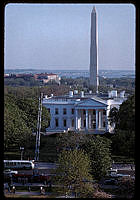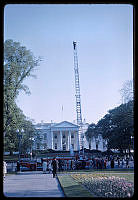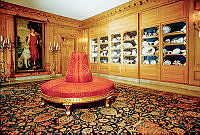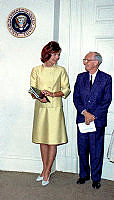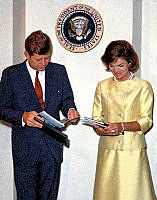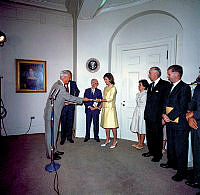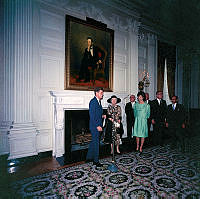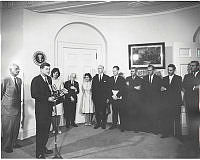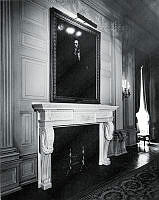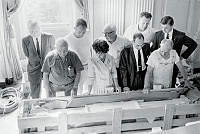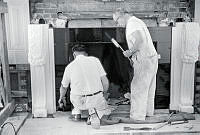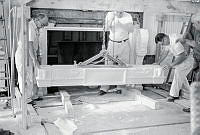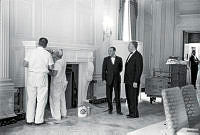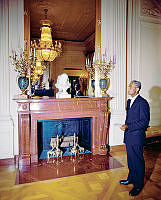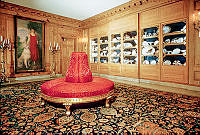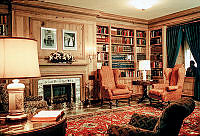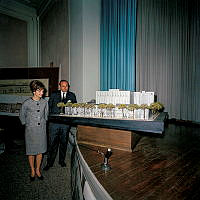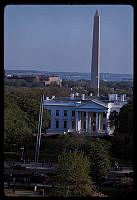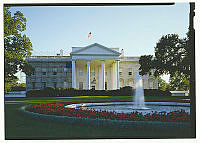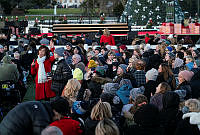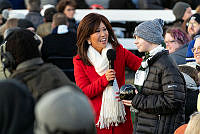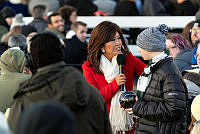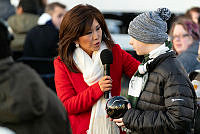TEACHER'S TEXT:
Most young children know the White House as the place where the president of the United States lives and works. The image of the building at 1600 Pennsylvania Avenue in Washington, D.C. is so widespread, and its history so enduring, that the building itself has come to symbolize American leadership. Journalists will write, "according to the White House . . ." as if the house and the executive who inhabits it are one and the same.
In November 1800, when John and Abigail Adams moved into what was then known simply as "The President’s House," it was still unfinished. Over the course of more than two centuries, there have been opportunities to make radical changes in the house, but presidents have stood firm and realized the symbolic importance of the White House and the need to keep the structure unchanged — at least to the eye of the observer.
The British burned the building in 1814. It has been expanded numerous times to accommodate the growing needs of the first family and the executive staff. The White House interior was completely gutted and redone during Harry Truman’s administration. Yet for all that, the core of the house looks remarkably similar to the structure that George Washington saw rise in the earliest days of the American republic.
This lesson will provide images of the White House over time. Young students will see how the President’s House grew outward, downward and upward. At the same time, they will also see how the building remains unchanged. In order for a symbol to have force, it must be fixed and consistent. A symbol represents a larger idea. The White House represents leadership and political freedom in America and around the world.
Download Lesson Plan
Download Activities
Objectives
By successfully completing this lesson and accompanying activities, students will:
- Understand how a symbol can represent an important idea.
- Comprehend how a building can be a symbol, and discuss other types of symbols and their meanings.
- Track the changes in the physical structure of the White House over time; see how the building has grown to fit the needs of the time, but still retains its original form.
National Standards for History
The history objectives and activities in "The White House: Symbol of Leadership" comply with the National Standards for History for Grades K-4, as developed by the National Center for History in the Schools, Los Angeles, CA.
Topic 3 The History of the United States: Democratic Principles and Values and the People from Many Cultures Who Contributed to Its Cultural, Economic, and Political Heritage
Standard 4E The student understands national symbols through which American values and principles are expressed.
LESSON PLAN:
What do you think of when you see a flag? What does it mean? When you see this red, white and blue flag, you think of America! The American flag is a symbol of our country.
Buildings can be symbols too. The White House is the home and office of the president of the United States. When people see a picture of the White House, they think of the leader of our country. The White House is a symbol of leadership. Some people from other countries also see the White House and think of freedom.
Today, you can see pictures of the White House on television, in newspapers, and in magazines. Here you will see pictures of the White House from long ago and from today. You will see how the middle part of the house has not changed much since John Adams was the first president to live there. But you will see the White House grow when more people live and work there. The house grew out, up, and down, but the middle part has stayed the same. This is important. If a symbol is going to make you think of an idea, like leadership, the symbol must not change.
The White House before it was built: White House architect James Hoban made a drawing in 1793. The drawing was used to help build the White House.
The White House when President John Adams lived there: The sketch shows the White House in the early days, about the year 1800.
The White House after it was burned by the British: The White House was burned in 1814. British soldiers came to Washington and set fire to it. You can see the burn marks near the windows.
The White House with wings: The White House about 1835. You can see one of the wings added to the side of the house. Wings on both sides were built because the president needed rooms for storing food and other items. Servants worked in the wings, too.
The First Photograph of the White House: It was taken about 1846.
The White House Greenhouses: Big glass buildings were built on one side of the White House. Plants grew in these greenhouses.
The West Wing of the White House: President Theodore Roosevelt tore down the greenhouses in 1902 and built offices on the west side of the White House.
The East Wing of the White House: Theodore Roosevelt built a new entrance to the White House in 1902. Visitors coming to a party would drive their carriages up this driveway to the East Wing. They would walk through the doors and through a hall to get to the middle part of the White House.
More Space on the Third Floor: President Calvin Coolidge decided more space was needed for the president's family. New rooms were built on top of the White House in 1927.
Repairing the White House and Building Two Basements: President Harry Truman had a lot of repairs done between 1948 and 1952. The old White House was falling apart. All the inside rooms were replaced and two basements were dug below the ground. The outside walls were saved.
The White House today: The stone walls have stood since President John Adams first occupied the house in 1800. There are wings on both sides of the White House but trees and bushes help to hide them. This is the famous White House that is known by people all over the world.



















